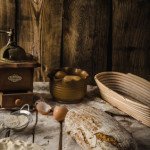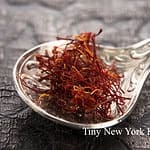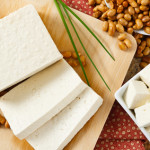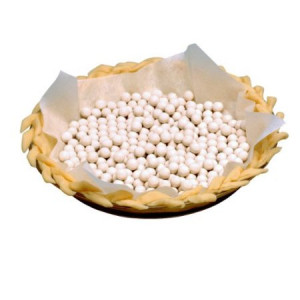Turn out amazing treats with these easy tips and tricks to help you bake your best every time.
Measure Flour Accurately
Using a measuring cup to scoop directly from the bag can pack in too much flour, leading to dry, dense baked goods. Use the “spoon and sweep” method by gently stirring the flour in the bag with a spoon. Spoon the flour into your measuring cup. With the back of a knife, level off the cup and sweep the excess back into the bag.
Warm Eggs To Room Temperature
Room temperature eggs blend more easily in batter and dough, and whites whip up with bigger volume. Take eggs out of the refrigerator a couple hours before baking or add cold eggs to a large-size bowl. Cover with warm, not hot, tap water. Rest for 5 to 7 minutes while you measure other ingredients.
Test Your Baking Soda And Baking Powder
These leaveners help baked goods rise. If they aren’t active, quick breads and pancakes will be flat instead of fluffy. Spoon baking powder and baking soda into separate small bowls. Pour boiling water into baking powder. Pour distilled white vinegar into baking soda. If the ingredients fizz, they’re still active.
Measure Liquid And Dry Ingredients Separately
Too much or too little liquid can change the texture and taste of the finished recipe. Liquid measuring cups give you room to pour right up to the fill line without spilling. Use clear measuring cups with pour spouts for liquids. Use flat-bottomed measuring cups for dry ingredients and use the “spoon and sweep method.”
Prevent Overbaking
Know your oven’s quirks. All ovens run slightly differently, and some spots are hotter than others. Keep an eye on how your baked goods are browning, the temperature, and the time to make the best estimate. Use an oven thermometer to see if your oven runs hot or cold (a few degrees above or below what the dial says), and adjust accordingly. Set a kitchen timer, and check for doneness a few minutes early. Rotate your pan halfway through for even baking.
“Work With What You Got!”
©Tiny New York Kitchen © 2019 All Rights Reserved
Just a few fresh berries add color and nutrients to a salad, cocktail, or mocktail.
Stock up on fresh berries, wash and freeze them in a single layer on a sheet pan. Then transfer to a freezer bag for future smoothies and baked goods.
Add a handful of berries to a parfait, with yogurt for breakfast or ice cream for dessert.
Gently fold berries into muffin and pancake batter. Cook a big batch and freeze some for easy breakfasts later.
Make into a savory salsa and serve as a dip or over grilled chicken or wild-caught salmon.
“Work With What You Got!”
© Victoria Hart Glavin Tiny New York Kitchen © 2017 All Rights Reserved
I grew up in the Midwest where it was considered a mortal sin to waste food. The motto was “waste nothing and make the most of every ingredient.” Here are some ways for you and your family to make the most of ingredients that otherwise may make their way into the trash bin.
Stewed Fruit does double duty as a topping for pancakes, waffles and ice cream while giving you a serving of fruit. Get started with apples and dried fruits.
Super Stems. Don’t waste the nutrients in stems of greens like collards and kale, or vegetables like broccoli and cauliflower. Use them in longer cooking soups and stews.
Save The Soft. Baked desserts are a great way to use up slightly overripe fruit.
Use It, Don’t Lose It. When you by a special ingredient for a recipe, don’t waste what’s left. Get creative and add them to some of your favorite recipes.
Make Soup with leftovers. Vegetables, grains, and meats make wonderful soups. If you don’t have time to make soup right away, freeze the leftovers until you have a good cooking day. Don’t forget to label and date what you’re freezing for later.
“Work With What You Got!”
© Victoria Hart Glavin Tiny New York Kitchen © 2017 All Rights Reserved
Figs are truly fantastic! Dried figs are available all year round and many markets offer luxuriously sweet fresh figs throughout the year as well. Figs are a healthy and portable snack that is packed with nutrition.
Figs are rich in potassium, which helps control blood pressure. They also provide calcium, magnesium, iron, and copper. Because they’re rich in fiber, figs support digestive health and may be helpful for managing a healthy weight. Figs are among the most alkaline foods and help balance the body’s pH.
Fresh figs are highly perishable, so they should be eaten a day or two after you purchase them. Look for figs that have a rich, deep color and are plump and tender, but not mushy. Wash them under cool water and remove the stem. Add fresh or dried figs to oatmeal, salads, cheese, and baked goods.
“Work With What You Got!”
© Victoria Hart Glavin Tiny New York Kitchen © 2017 All Rights Reserved
Bread can be either leavened or unleavened. Leavened breads are made with rising agents, like yeast or baking powder, which allows the dough to release gases and expand. Unleavened bread contains no yeast, baking soda, baking powder or other leavening agents that allows dough to rise.
Leavened and unleavened bread are nutritionally similar.
It is generally, not a good idea to refrigerate bread. Although bread will last longer when refrigerated, it tends to dry out faster and to lose its soft texture.
As a general rule, bread should be kept in a somewhat air-tight and dry container or area.
Hot bread should not be put in a sealed container until it cools since the steam will cause dampness, which in turn can cause mold to grow more rapidly.
Storing bread on top of the refrigerator is not recommended. Refrigerator tops are usually very warm and this could either cause your bread to dry out more rapidly or cause condensation in the bag.
“Work With What You Got!”
© Victoria Hart Glavin Tiny New York Kitchen © 2016 All Rights Reserved
Saffron
Highly prized as a dye, medication and culinary spice since Greek and Roman times, saffron is the stigma of a type of crocus, Crocus sativus, which was once grown all over Europe, including in England. It has a distinctive and lasting aroma, and a pleasant pungency if used sparingly. Because of its striking color, as well as its distinctive flavor, saffron is frequently added to celebration dishes; for example, pilaus from India, Spanish paella and Italian risotto Milanese. Bouillabaisse, the famous French fish and shellfish soup-stew, is flavored with saffron. The spice is also widely used in sweet recipes, including milky rice and sweet custard-like desserts. Baked goods flavored with saffron include breads and cakes.
Saffron threads can be infused (steeped) in a little warm water or milk until the color of the liquid is even. Add the liquid and the threads to the dish, usually towards the end of the cooking process. Saffron powder can be added to food without soaking, but not to hot oil.
“Work With What You Got!”
© Victoria Hart Glavin Tiny New York Kitchen © 2016 All Rights Reserved
Ways To Make The Most Of Seasonal Citrus
Zest It
Add zip to baked goods, stir-fries or stews. Make citrus salt!
Juice It
Lemons juice helps keep sliced fruits and root vegetables from turning brown. Finish savory dishes with a squeeze of lemon juice to enhance the flavors.
Freeze It
Freeze citrus juice or zest until you’re ready to use it.
Dry It
Bake peels on the lowest possible heat until dry, but still pliable. Use to flavor black tea, roasted chicken or braised meats.
Candy It
Garnish desserts and cocktails with candied peels or enjoy them as a sweet snack.
“Work With What You Got!”
© Victoria Hart Glavin Tiny New York Kitchen © 2016 All Rights Reserved
Storing Baked Goods
Always allow baked goods to cool completely (preferably on a wire rack) before wrapping and storing. If they are wrapped before they are thoroughly cooled, pastries will steam, turning their nice crisp surfaces soggy and limp. The texture and flavor of most baked goods fare best when stored, well wrapped, in a cool dry location for a couple of days. However, those that are particularly high in moisture will be safest stored in the refrigerator.
“Work With What You Got!”
© Victoria Hart Glavin Tiny New York Kitchen
 Pre-Baked Pie Crust: Five Steps For A Perfect Pie Crust
Pre-Baked Pie Crust: Five Steps For A Perfect Pie Crust
A pre-baked pie crust (sometimes called a blind baked pastry case) is one that has been partially baked without a filling so it can still cook and crisp thoroughly if the filling needs a shorter time to bake than the pastry. Pre-baking a pie crust also stops the pastry from getting soggy by a moist filling.
- Prick the base of the pie crust all over with a fork to stop the pastry from bubbling up and getting out of shape.
- Chill the pie crust in the refrigerator for at least 15 minutes before baking. This will stop it from shrinking during baking. Preheat your oven to 350º F.
- Place a large piece of parchment paper inside the pie crust, then fill with baking beans or uncooked rice. Ceramic beans or pie weights are available from most cooking stores or Amazon. Make sure that the paper is touching the pastry, eve at the edges.
- Bake for 10 to 15 minutes for a large pie crust or 8 to 10 minutes for a small one until the pastry is cooked and opaque.
- Carefully remove the parchment paper and the beans/rice/weights and then return the empty pie crust back in the oven for 10 minutes for a large pie crust or 4 to 5 minutes for a small one. When it is ready the base will be a sandy color, dry and crisp. The top edges of the pie crust should be golden. Leave in the pie tin or pie plate and continue with your chosen recipe.
















